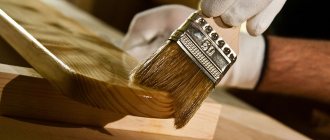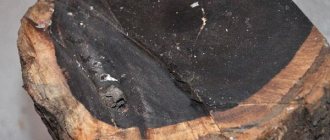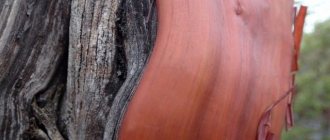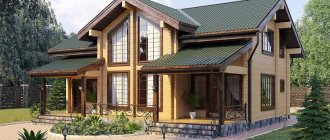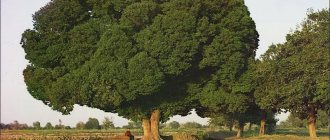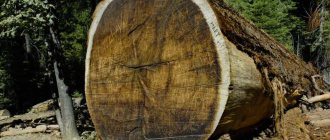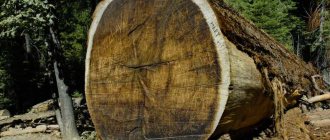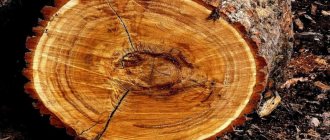The most convenient material for building a house or cottage is wood, since its thermal conductivity remains constant over a wide temperature range from -40 to +40 degrees. But there are other factors that affect the thermal conductivity of materials, including wood. For example, humidity, on which the thermal conductivity of wood largely depends.
Pine is a wood often used in construction.
What is thermal conductivity index
In every home, the outer and inner surfaces have different temperatures. A flow of heat flows from a warmer place to a colder one, and in different materials heat is transferred at different rates. This depends on a special property of materials called thermal conductivity.
The property of materials to conduct heat from a hotter place to a colder place through the random movement of atoms and molecules is called thermal conductivity. Heat is transferred through chaotic collisions of these particles with each other.
When considering the issue of building construction, the transfer of heat and its loss, provided that the walls are smooth, thermal conductivity is considered not a random flow, but a directed one. In this case, the temperature outside and inside the building is taken into account, and not on the surface of the wall. From here the thermal conductivity of wood is calculated.
Why is it cold in a barrel sauna in winter?
Sometimes people complain that it is cold in the barrel sauna in winter. Now you know why this happens. If you make a barrel sauna from pine, it will a priori be cold in winter. There is no need to spend money and test it empirically; you have proof in numbers - the thermal conductivity table. Even at positive, but low temperatures, you will have to heat more to maintain the required temperature. And in sub-zero winters it is impossible to steam at all - the bathhouse will cool down very quickly.
Therefore, if you decide to buy or build a bathhouse yourself, choose cedar. And don’t throw your money away, and you will enjoy and enjoy for many years.
In addition to the fact that cedar retains heat well, it is also, unlike pine, not susceptible to mold and rot. Pine is soft, if it is not regularly treated with protective compounds, it begins to “turn blue” and rot, because Mold forms between the fibers. Although pine is the cheapest material, in this case, chasing cheapness is not the best option.
Go to the catalog and choose your barrel sauna
Thermal conductivity of wood
It is convenient to build houses, cottages and other objects of different sizes from wood. The most important factor is the low thermal conductivity of this material. Heat is best retained in a house built of cedar. After it comes spruce, then larch. Pine conducts heat the most, as does oak.
Differences in the cross-sectional structure of cedar, sona, and spruce wood fibers
The thermal insulation properties of wood have been known to man for a long time. In the ancient world, people used wood to make various buildings, beds, chairs and even dishes. Dry wood almost does not conduct heat, since the internal structure has many air pores. If you lean your hand against a wooden surface, you feel warm. This occurs due to the slow release of energy from the human body.
Today, laminate flooring has become popular in apartments. But this material is much cooler than natural wood. The heat conductivity of wood largely depends on its density. The larger it is, the better the heat is conducted. In addition, the direction of the wood grain and moisture content are important. As the water content in wood increases, its thermal conductivity increases sharply.
Electrical conductivity
Electrical conductivity, or the ability to conduct electricity, is determined by the amount of resistance that wood offers to the passage of electric current through it.
Dry has a fairly high resistance and can be classified as a semiconductor. As humidity increases, the resistance decreases and it becomes a conductor. The decrease in resistance occurs until the saturation point of the fibers, after which the electrical conductivity does not change.
The resistance of wood to the passage of electric current along the fibers is much less than across it, and decreases with increasing temperature. In table Figure 5 shows the resistivity in Q-cm.u at t° 20° for some rocks (according to Mikhailov).
Table 4. Wood resistivity
The dependence of the electrical conductivity of wood on its moisture content was used in the construction of an electrical device for quickly determining moisture content. By measuring the resistance to the passage of current with such a device, you can determine the humidity using special tables (or directly on the scale of the device). This method of determining humidity requires very little time, but the accuracy of such devices is still low (1-2%). In addition, these devices are not suitable for determining moisture when it is above the saturation point of the fibers. Nevertheless, in warehouse practice, these devices can be useful for quickly sorting wood by moisture content.
Wood as a building material
Wood has always been used as a building material. It is second only to stone in terms of popularity. The chemical properties of wood are quite complex, but people have successfully used the unique properties of this material for construction.
Wood is widely used to build houses, boats, and home furniture. The great advantage of wood is that it is a natural material. This makes it cost-effective and accessible. Wood has sufficient strength and provides the necessary thermal insulation.
Wood is easy to work with and can be shaped into different sizes and shapes to create any design. Wood is a biodegradable, environmentally sustainable product. It has the lowest carbon footprint of any building material.
Wood extraction does not require high-energy fuels compared to plastic, iron or brick. Over time, the tree in nature gradually renews itself. When constructing objects, wood in combination with other materials provides long service life, fire resistance, insulation from moisture, noise and cold.
Why is this necessary?
One of the main problems of modern construction is energy efficiency, that is, saving thermal energy by minimizing losses through building envelopes.
The current SNiP 02/23/2003 in one of the annexes contains the parameters of the thermal resistance of walls recommended for construction in different regions of the country. Here are their meanings:
| Region | Thermal resistance of walls, m2*S/W |
| Sochi | 2,0 |
| Volgograd | 2,8 |
| Moscow | 3,5 |
| Novosibirsk | 4,2 |
| Khabarovsk | 4,9 |
| Yakutsk | 5,6 |
To calculate the actual thermal resistance of a wall made of a known material, it is enough to know the thermal conductivity of the material and its thickness. The relationship between the quantities is simple and clear: thermal resistance is equal to the ratio of thickness to thermal conductivity.
Let us clarify: with a multilayer structure of the enclosing structure, the resistance is calculated for each layer; the results are summarized.
With a multilayer wall structure, the thermal resistance is calculated for each layer.
Thermal conductivity and other properties of wood of different tree species
If you analyze the data from the table, you can understand that the thermal conductivity of wood is less than that of other wall materials. Only a few innovative materials can compete with wood.
| Construction material | Density, kg/m3 | Thermal conductivity, W/(m * deg) | Heat capacity, J/(kg * deg) |
| Birch | 510 — 770 | 0.15 | 1250 |
| Poplar | 350 — 500 | 0.17 | — |
| Pine and spruce across the grain | 500 | 0.09 | 2300 |
| Resinous pine 15% humidity | 600 — 750 | 0.15 — 0,23 | 2700 |
| Linden, (15% moisture) | 320 — 650 | 0.15 | — |
| Oak along the grain | 700 | 0.23 | 2300 |
| Oak across the grain | 700 | 0.1 | 2300 |
| Pine and spruce along the grain | 500 | 0.18 | 2300 |
| Fir | 450 — 550 | 0.1 – 0.26 | 2700 |
| Cedar | 500 — 570 | 0.095 | — |
| Maple | 620 — 750 | 0.19 | — |
| Larch | 670 | 0.13 | — |
Humidity and density of wood have a great influence on the conduction of heat. In addition, the same breed can manifest itself differently, depending on the region of growth. Therefore, in the table you can see several parameters for one type of tree.
Cedar is considered the “warmest” tree. It conducts heat the least, so houses made of this material will be the most economical in terms of heating costs.
Spruce and fir will also be a good choice for building a warm house. However, fir should not contain a lot of resin, which greatly reduces heat retention.
The density of coniferous trees largely depends on the region of growth, which affects the thermal conductivity of the wood. For example, Astrakhan pine is famous, from which masts are made. In the Vologda region, builders more often choose spruce rather than pine.
During construction, the average value of thermal conductivity for pine wood is often taken into account - 0.15 W per m * C. In fact, if you take dry wood, then for spruce, pine and fir the thermal conductivity coefficient is 0.13, and for cedar it is no more than 0.1. Gas silicate blocks, which are manufactured in autoclaves, have approximately the same characteristics.
Might be interesting:
- What is better to choose: a house made of timber or frame
- DIY timber house
3sound absorption
3sound absorption is characterized by the sound absorption coefficient, which determines that part of the sound energy incident on the test object that is not reflected from it. The sound absorption coefficient determined using the standing wave method has the following values (Table 3).
Sound absorption depends on pitch and is less for wood than for brick. The ability of materials to absorb sound is of paramount importance when constructing auditoriums, concert halls, theaters and similar premises. Table 3. — Sound absorption coefficient
| Material | Coef. sound absorption at vibration frequency | |||
| 297 | 569 | 1 095 | 2 890 | |
| Brick | 0,019 | 0,019 | 0,019 | 0,021 |
| Pine | 0,012 | 0,009 | 0,016 | 0,009 |
| Oak | 0,011 | 0,007 | 0,011 | 0,005 |
Wood wall thickness
If we take into account the thermal conductivity coefficient of 0.13 for central Russia, then the walls of houses must be made 0.11 x 3 = 0.33 meters thick. This is where the average thickness of a pine wood wall is taken. This is the standard for conditions for saving heat and energy reserves.
Everyone is used to seeing the walls in the house as flat and even. It is known from physics that heat is transferred through the random movement of particles. But, when the wall is flat, heat is transferred linearly and directionally from a place with greater heating to a lesser one.
If the walls of the building are made of logs, then the situation changes somewhat. The round surface of the logs creates heat direction vectors in different directions. As a result, the thickness of the wall is the diameter of the log, and the bottleneck is not taken into account. The section of the inter-crown groove (thermal bridge) is often mistaken for a “cold bridge” by analogy with the mortar during the construction of a brick wall.
But, in addition to the thickness of the wall, the temperature in the room plays a big role. It may also turn out that building a warm house will not be economically viable. After all, the costs of its subsequent repairs may be too high and will not cover the cost of heating.
Soundproofness
Sound transmittance is the ability of a material to transmit sound; this ability is characterized by the sound transmission coefficient, i.e. the ratio of the amount of sound energy passing through a given object (wall, partition) to the amount of energy falling on it.
If the sound permeability of an open window is taken as unity, then for a glass plate the coefficient. sound permeability will be 0.37, and for a pine panel - 0.19. The sound permeability of materials is of great importance in residential construction, where special measures are taken to soundproof rooms. Sound can be transmitted from room to room through the air (loud conversation, playing musical instruments, etc.) or by material transfer (knocking, walking, etc.).
In the first case, a good insulator will be a high-density material through which sound travels well; but in the second case such materials are completely unsuitable. Here it is necessary to use a material of low density, with a low speed of sound propagation in it. The sound insulation ability of materials can therefore be characterized by the product of the speed of sound propagation in a given material and its volumetric weight. This product, sometimes called sound impedance, is not the same for different materials (Table 4).
Table 4. Soundproofing ability of various materials.
| Material | Volume weight | Spread speed sound in m | Sound impedance |
| Air | 0,0013 | 340 | 0,44 |
| Glass | 2,5 | 5 000 | 12 500 |
| Oak | 0,7 | 3 380 | 2 336 |
| Spruce | 0,5 | 5 250 | 2 625 |
| Cork | 0,2 | 500 | 100 |
Features of wood structures
Most often, for the construction of a warm house, cottage or summer house, timber with a standard section of 150x150 mm is used. It is made of coniferous trees, which have the right ratio of cost and thermal conductivity.
The wall must be 450 mm thick to retain the required amount of heat, and the timber is only 150 mm in size.
The question is that in construction, in addition to wood, other new materials are also used. After all, a purely wooden house will turn out to be very expensive. It would be most profitable to make thin wooden walls and then insulate them with synthetic materials.
This is especially suitable for the northern regions of Russia, where frosts can reach -50 degrees. In addition to excellent heat retention, wood has other important properties that brick, stone or concrete do not have. For example, elasticity, wear resistance, ease of processing.
conclusions
Houses made of laminated veneer lumber are warm and comfortable. They retain heat well in winter and cool in summer, require relatively low heating costs and have a pleasant microclimate. But in order for the built house to be as comfortable as possible and protected from significant heat losses, it is necessary to use an integrated approach to ensuring its energy efficiency even at the design stage. Houses for permanent residence are usually built from laminated veneer lumber with a cross-section of 200x280 or 212x192 mm, and in the coldest regions, timber with a cross-section of 240x192 or 240x280 mm is used.


